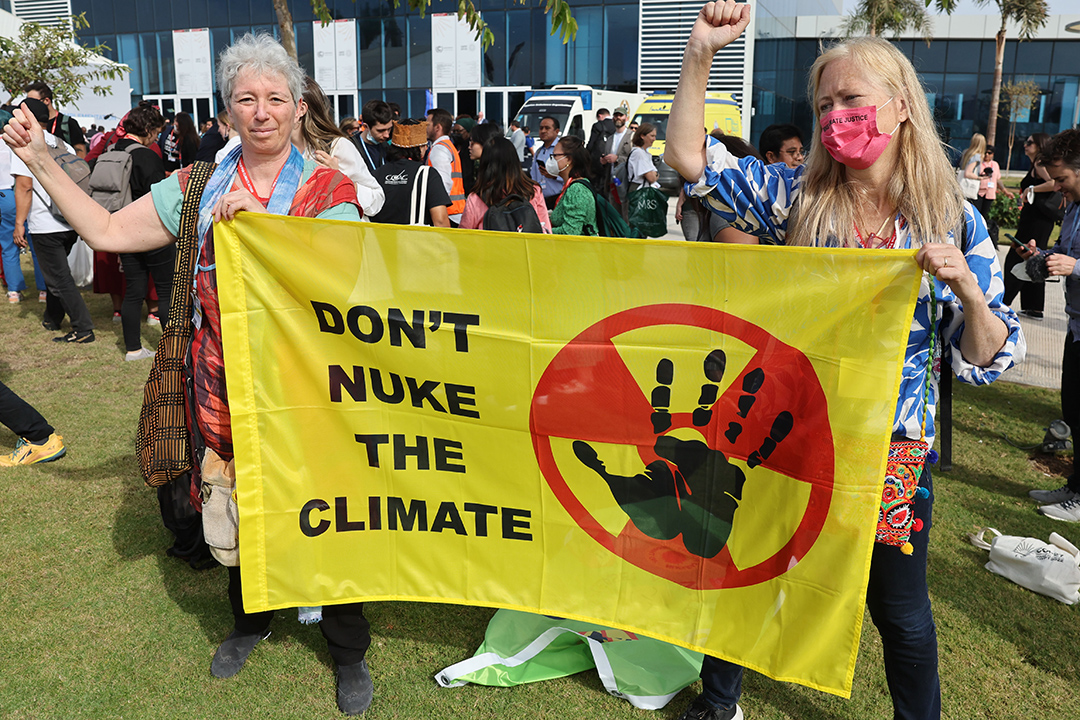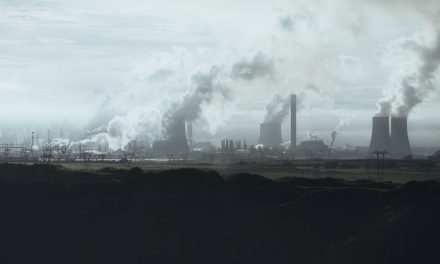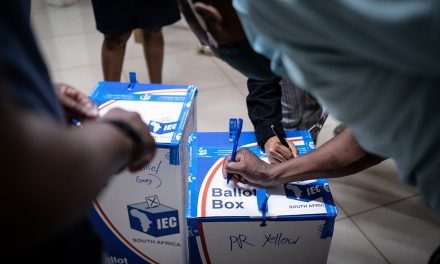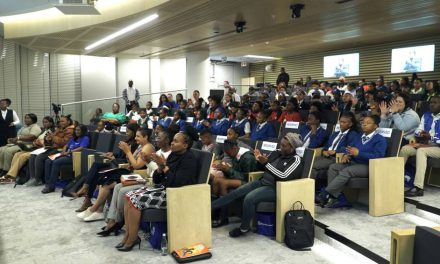The 27th UN Climate Change Conference of the Parties (COP27) is taking place in Egypt’s Sharm el-Sheikh, running over two weeks (5 – 18 November). The COP aims to tackle key concerns on the global agenda toward action against climate change.
This year’s summit takes place against the backdrop of a growing energy crisis, record greenhouse gas concentrations, increasing extreme weather events globally, the Russian-Ukraine war and its impacts on key global supply chains and related markets such as energy and food, as well as unpredictable diplomatic ties between the world’s top greenhouse gas emitters; the United States and China.

Climate activists protest outside the Sharm el-Sheikh International Convention Centre, during the COP27 climate conference in Egypt’s Red Sea resort city of the same name, on November 17, 2022. Photo by AHMAD GHARABLI/AFP
To add insult to injury, during the opening session of the conference, the World Meteorological Organisation (WMO) revealed in its latest report that “the past eight years were on track to be the warmest on record” – meaning that at COP27 world leaders need to prioritise tangible, achievable outcomes and they need to deliver them now.
These will be just some of the issues that leaders, policymakers and delegates from nearly 200 countries have convened again to discuss. For representatives from African nations, however, the optimism is that this year’s COP will address many of the loose ends of the 2021 Glasgow Climate Summit, COP26.
This includes addressing the following critical issues:
- Adaptation, loss and damage
The African continent is increasingly impacted disproportionally by the effects of climate change. Yet, the continent’s total carbon dioxide emissions only constitute around 4% of global emissions (Figure 1). Within that, 80% of Africa’s total emissions originate in lower to upper-middle-income countries: South Africa, Egypt, Algeria, Nigeria, Morocco, Libya, Tunisia, Sudan, Angola and Kenya.
Figure 1
Extreme weather and climate variability afflict the continent with growing frequency. This has a direct impact on economic, ecological and social systems that threaten to disrupt all aspects of human security – from land and food to infrastructure and access to water. Moreover, the WMO’s State of Climate in Africa report (2020) indicated that by 2030, nearly 120 million people living in extreme poverty (i.e. living on less than US$2 a day) will experience longer warmer seasons, shorter colder seasons, increased heat waves, and exposure to water stress and hazards like withering droughts and devastating floods if drastic measures are not established and implemented.
To this end, attempts to address climate-vulnerable countries were first formally highlighted at the COP15 in 2009, in Copenhagen. These included ambitions to commit to a collective goal of mobilising 100 billion USD in finance for climate adaptation. The goal was formalised at COP16 in Cancun, and at COP21 in Paris, it was reiterated and extended to 2025, through the Paris Agreement. The Paris Agreement was the first-ever universal, legally binding global climate deal that aimed to contain global temperature increases to 2°C (or ideally 1.5°C) above pre-industrial levels, to reduce greenhouse gas emissions and critically, to address climate adaptation through financial and other supports for developing countries.
By 2019, however, developed countries had yet to and only managed to deliver 80 billion USD. At COP21, low-income and climate-vulnerable countries sought to address this deficit as well as double adaptation finance by 2025. However, a report by the UN Trade and Development office, estimated that for low-income and climate-vulnerable countries to adapt successfully by 2030, approximately 300 billion USD will need to be mobilised. Thus, the pledge to double adaptation finance made at last year’s COP26 in Glasgow falls short and it is hoped that at COP27, enhancing adaptation finance will be confronted.
Another critical adaptation and mitigation issue on the agenda for the first time since climate talks began decades ago, will be establishing a loss and damage fund. For decades, low-income and climate-vulnerable countries have sought a fund to cover the costs already being incurred from climate-fuelled weather extremes and impacts. So far, adaptation finance has focused on reducing carbon emissions as a means of staying within the 1.5°C above pre-industrial levels limit as well as financing projects that assist communities in adapting to future climate change impacts. Loss and damage, however, refers to compensation for costs incurred due to climate change that countries can’t avoid or “adapt” to.
The issue has historically been circumvented by wealthy nations that have rejected the proposal of opening official discussions on the matter. During COP26, high-income nations, like the US and those in the European Union, blocked proposals that officially put the establishment of a loss and damage fund on the agenda.
This has occurred for two reasons. First, there is little agreement over what “loss and damage” on account of climate disasters should include, i.e., where the funds should come from, how much is needed, and which countries or disasters qualify for compensation. Second, countries in the EU and the US have been tentative about establishing a fund, citing legal liabilities as the reason for the hesitation, instead of favouring a position of being open to dialogue on the matter. Elsewhere, countries such as Austria, Germany, Belgium, Ireland, Canada and New Zealand have recently reaffirmed or increased their commitments to loss and damage finance for vulnerable countries on the continent. It is hoped that COP27 will further yield constructive progress in this regard.
- A Just Transition
Another critical point of contention over the last few COPs has been phasing out the use and dependence on fossil fuels and transitioning to renewable energy sources. At COP26, countries and institutions committed to ending the support of fossil fuels and prioritising finance for clean energy by 2022. However, the impact of the Russia-Ukraine war led several European nations to return to fossil fuel use. The UK has approved several fossil fuel projects since the last COP. Additionally, China continues to approve new coal mines as well as invest in huge infrastructure projects on the African continent. This backsliding from major economies on their commitment to reduce fossil fuel consumption in light of the global energy crisis has fuelled allegations of hypocrisy. As such, many African policymakers have cited the continent’s own energy deficit and security issues in arguments against disinvestment. However, one must ask why African countries endowed with fossil fuels have, until now, not utilised these resources for widespread electrification.
Figure 2
As mentioned above, 10 African countries are responsible for 80% of the continent’s total emissions. Barring them, many sub-Saharan countries’ emissions from energy sectors are only the third highest when compared to agricultural or Land Use Change and Forestry (LUCF) in most cases (Figure 2). Thus, their energy sectors remain underdeveloped and they are minor contributors to global emissions. As a result, a disjuncture is created between the realities on the ground and the COP agendas. Moreover, a report by the Mo Ibrahim Foundation notes that over 600 million people in Africa still lack access to electricity. Yet, at COP, low-income and climate-vulnerable countries are often discouraged from using their own energy resources, instead being encouraged to prioritise renewable energy sources to pursue industrialisation.
According to Sudanese-British businessman Mo Ibrahim, “renewables alone will not be sufficient to bridge Africa’s energy gap any time soon and provide the reliable energy supply needed for industrialisation”.
As such, proposals that encourage a just transition as a means of progressing to resilient, industrialised economies often overlook the pressing need for energy justice within the continent and risk undermining African people’s right to energy. Ultimately, before renewables become an achievable goal, most African countries will need time and finance to develop a diverse energy mix that withstands the climate uncertainty attached to the use of solar, wind and hydropower alternatives.
It is also true that in the long run – given adequate time and finance – Africa is primed to transition to renewable sources and support green energy in the global economy. Over a third of the world’s mineral reserves are found in Africa and with a global shift to low-carbon technologies, Africa should be well equipped to place itself at the centre of this demand.
One thing is certain, there can be no climate justice without energy justice and climate compensation. If African nations are to achieve their development goals, they must be allowed to prioritise industrialisation independently, at their own pace and within sustainable, achievable frameworks.
Mischka Moosa is a data journalist at GGA. She holds a Bachelor of Social Science with majors in Gender Studies and Political Science that she obtained from the University of Cape Town. Her focus of interest is on decolonial approaches to justice, development and transformation in Africa.











